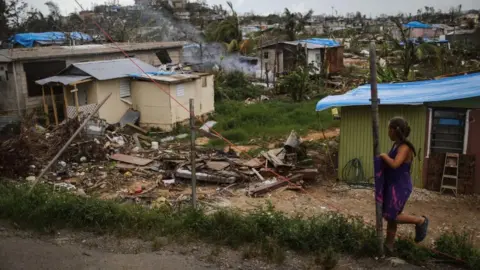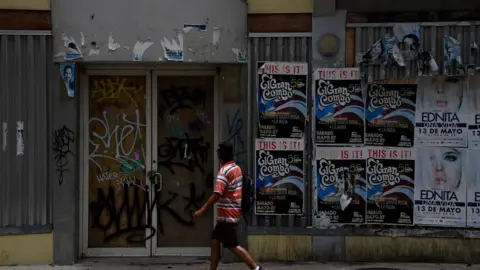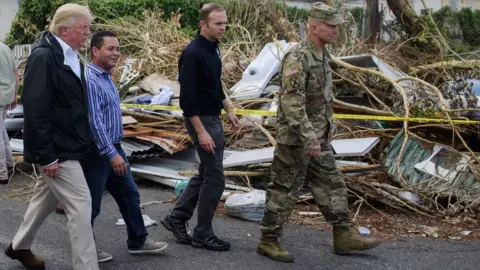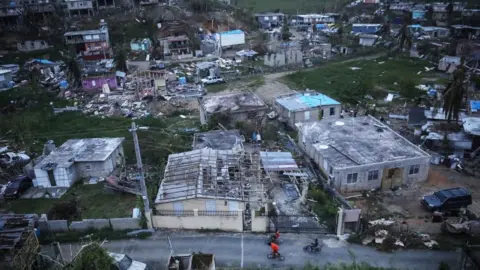What is Trump's plan for Puerto Rico?
 Getty Images
Getty ImagesPresident Donald Trump has been bellyaching about Puerto Rico's parlous finances, as the US territory struggles to regain its footing after Hurricane Maria.
His focus on the Caribbean island's more than $70bn (£53bn) debt mountain has renewed questions about how it is to be solved.
So what's the plan for Puerto Rico?
The Puerto Rican government can't borrow money on the private market to rebuild due to the debt problems.
Hurricane Maria, which brought economic activity to a halt, has also created an immediate fiscal crisis: the government is running out of money.
Congress has just approved more than $36bn in disaster funding, including a $4.9bn loan to keep Puerto Rico operating.
But the remainder will be divided up among all areas affected in recent storms, including Texas and Florida.
Lawmakers in Congress have said they will consider additional funds for more long-term building efforts, but it's not clear how much that might be.
Moody's Analytics estimates property damage from Hurricane Maria could reach as high as $55bn, with total losses hitting $95bn.
Governor Ricardo Rossello has said the island of 3.4 million people, many of whom live in poverty, faces an "exodus" without a strong aid package.
Already Puerto Rico's population has plunged by more than 10% since 2006 amid a years-long recession precipitated in part by the end to tax benefits for manufacturers on the island.
 AFP/Getty
AFP/GettyRepresentative Rob Bishop, whose committee oversees US territories, including Puerto Rico and the US Virgin Islands, said he expects funding for recovery on Puerto Rico to be "significant".
He added that he is focused on legal changes to ease deployment of that money and encourage private investment.
"The federal government by itself is not going to just rebuild two territorial economies [including the Virgin Islands]... going forward," he said.
What are the politics?
Puerto Rico's power in Congress is limited by its status as a territory and not a state.
It has traditionally found its strongest allies among Democrats, many of whom have slammed the Trump administration's response to Hurricane Maria as slow and inadequate.
The White House has said it is committed to the island and President Trump has dismissed the criticism as political posturing.
But the president has shown reluctance to help Puerto Rico before.
In a tweet this spring, he described funding for Puerto Rico as a "bailout" proposed by Democrats.
On Thursday, he laid responsibility at the door of lawmakers, tweeting that it is for "Congress to decide what to spend".
 AFP/Getty
AFP/GettyMatt Fabian, a partner at the research firm Municipal Market Analytics, said he doesn't see appetite for major rebuilding funds for Puerto Rico, especially given constraints created by the Republican push for major tax cuts.
"This is not the Congress that is going to provide large unfettered aid for Puerto Rico," he said.
What about the debt?
In 2016, Congress tried to address Puerto Rico's fiscal crisis through the so-called Promesa law.
The law put the island's finances under the control of a federal oversight panel and created a way to restructure the debts under cover of a kind of bankruptcy protection.
The storm leaves negotiation of those questions back at square one.
 Getty Images
Getty ImagesHurricane Maria could give negotiators for Puerto Rico a stronger hand in debt-restructuring talks, bolstering the argument that the government and its agencies cannot pay the debts, Mr Fabian said.
He said the destruction may have also created new opportunities to create deals with bondholders, if the government moves to privatise infrastructure and publicly owned utilities as part of the rebuilding effort.
Can US just wipe out the debt?
President Trump earlier this month appeared to raise the tantalising possibility, when he told broadcaster Fox News: "We have to look at their whole debt structure."
"You know, they owe a lot of money to your friends on Wall Street, and we're going to have to wipe that out. You can say goodbye to that."
The prices of Puerto Rican bonds plunged after the remarks.
But White House advisers swiftly walked back the statement, saying the administration will stick to the path established by Promesa, and that Wall Street shouldn't take the president's comments "word for word".
 Getty Images
Getty ImagesThe president cannot unilaterally eliminate the debt - the subject of court battles that are just getting started - and while the federal government could, theoretically, step in and pay off the debts, analysts say politics makes that unlikely.
Some hope aid can lift the economy, ultimately generating tax revenue - and easing repayment of its debt.
But others say the storm will accelerate the island's economic contraction, as people leave for the mainland.
